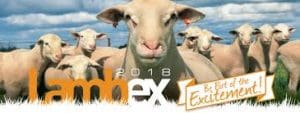 MARBLING might be a common breeding goal for the beef industry but it could soon be a major factor for lamb producers too.
MARBLING might be a common breeding goal for the beef industry but it could soon be a major factor for lamb producers too.
Intramuscular fat and its link to eating quality was a key to presentations made by Murdoch University Professor Dave Pethick and post-doctoral research fellow Dr Sarah Stewart at a session at LambEx in Perth this week.
Professor Pethick said intramuscular fat played an important role in determining the eating quality of lamb.
But a push to lean meat yield without taking IMF into consideration had a negative effect on eating quality.
This, Professor Pethick said, had happened in other countries which had “trashed their eating quality and their sheep” by following a path of only looking at lean meat yield.
Sheep breeders onto lean meat yield eating quality impact

Professor Dave Pethick
He said Australia had pushed down the lean meat yield path and had made good progress. The impact on eating quality was recognised and “as an industry, we are onto it”.
And it is the breeding more than the feeding which will help Australian lamb producers to maintain eating quality.
“While feeding regimes do have an impact, it is the genetics which hold the key to boosting IMF levels,” Professor Pethick said.
“Genetics of eating quality are here right now and I’d imagine it should be pretty easy to get onto it.
“The bottom line is to reinforce the role genetics has to set the IMF up (in the lamb carcase).”
He said higher energy diets of grain or good pasture would help the development of IMF but it also helped the development of other fat depots around the lamb’s body including around organs. Diet could also deplete IMF levels in certain cases.
“We fed just straw to lambs for two weeks, and the weight loss in lambs reduced IMF by one whole percentage unit,” Professor Pethick said.
“Potentially IMF it is quite a volatile (fat) depot though no accurate work has been done on that.”
“What is known is that one fat score will give you about 0.2 units of IMF, while one kilogram of carcase weight will give you 0.04 units of IMF.
“Fatness and weight are important (for IMF) but you still need genetics.
“The take home messages are that lean meat yield is important, eating quality is important, but remember, both are needed to predict eating quality.
“Lean meat yield is a negative predictor and IMF is positive predictor.”
Progress in measuring IMF in lambs
Murdoch University’s Dr Sarah Stewart gave Lambex delegates an insight into progress in measuring eating quality traits. She is working with Advanced Livestock Measurement Technologies (ALMTech) to investigate devices which can objectively measure carcase traits such as IMF to predict eating quality in both lamb and beef.
She said objective carcase measurement was essential for value-based marketing.
“Online measurement of IMF percentage is essential for the roll out of a cut-based MSA grading system for lamb,” Dr Stewart said.
“It is essential that technologies are developed which predict IMF percentage on an individual carcase basis.”
But she said commercialisation of technologies and effective roll out would depend on the precision and accuracy of the devices as well as the associated infrastructure and data management requirements within plants.
She is currently investigating three different devices which could measure carcase IMF – near infared hyperspectral imaging and the MEQ probe, which earlier this year came second in the Pitch in the Paddock competition held at Beef 2018 in Rockhampton (see earlier story).
Each of the three devices had their benefits. The near infared cameras can be used on hot or cold carcasees but requires a cut surface to measure IMF.
Very recent test results using hyperspectral imaging which were released in the past week show that this method can predict IMF percentage with a low error.
The MEQ probe shows promise, Dr Stewart said, and further industry validation is now being conducted, but the advantage of this probe was that there was no need to cut the carcase and it could be used on both hot and cold bodies.
“We desperately need an online prediction of IMF we can roll out into plants so we are able to select for eating quality in parallel with lean meat yield,” she said.

HAVE YOUR SAY